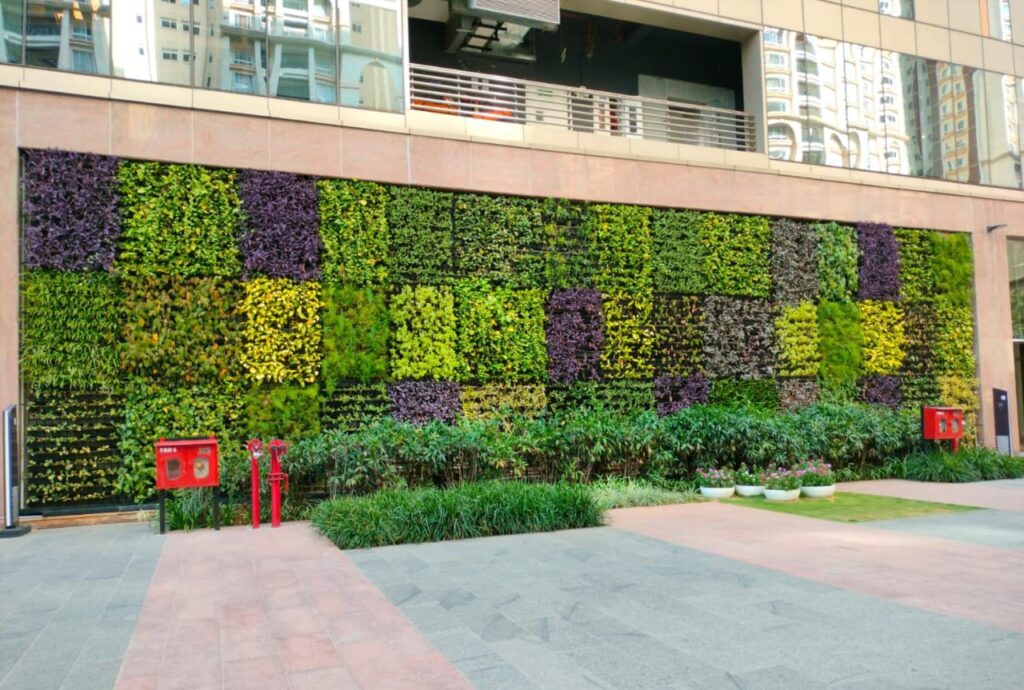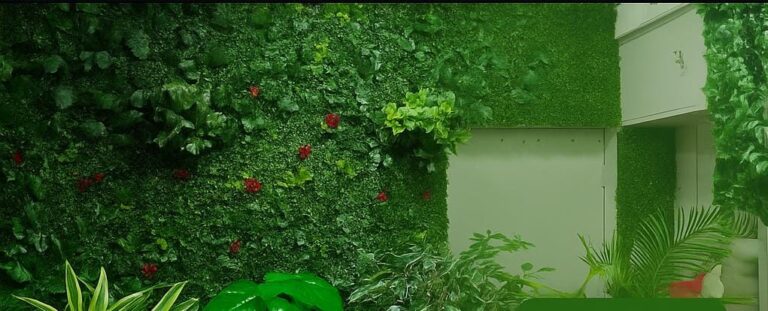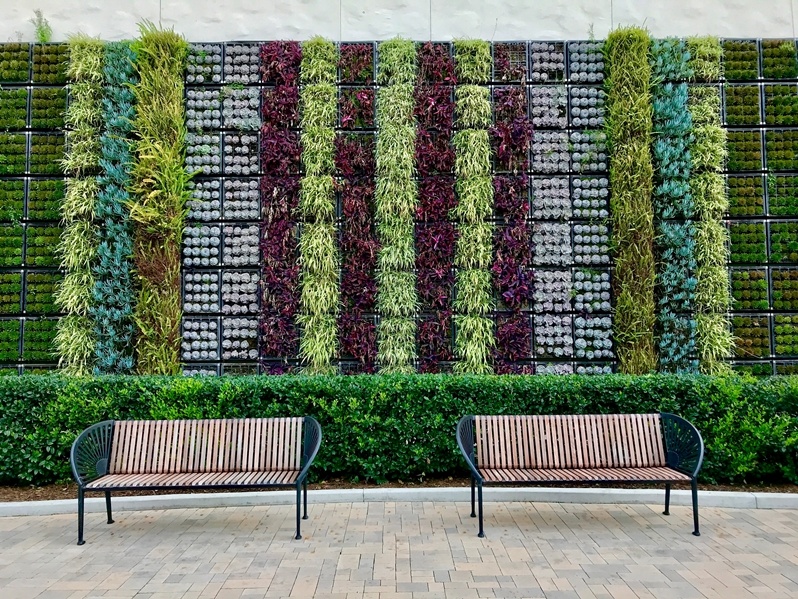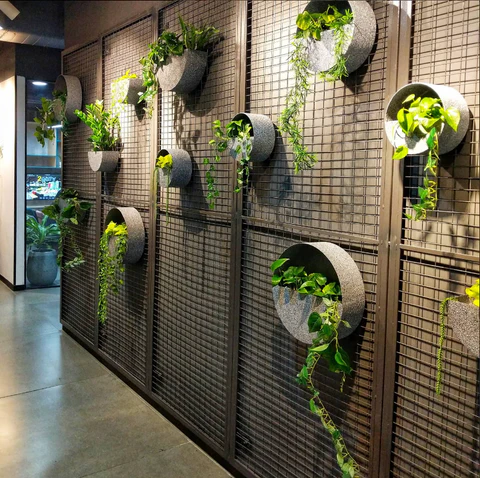What is Vertical Gardening?
Vertical gardening is a modern gardening technique where plants are grown vertically on walls, panels, or structures instead of the traditional horizontal ground space. It is an innovative solution for urban homes, balconies, terraces, and small backyards where space is limited. Apart from saving space, vertical gardens improve air quality, reduce heat, and add aesthetic beauty to your surroundings.
Vertical gardens, also known as green walls or living walls, are vegetation-covered structures that are installed on vertical surfaces, such as interior walls or exterior facades. These gardens can be created using a variety of plants, substrates, and irrigation systems, adapted to grow vertically.

Benefits of Vertical Gardening
- Saves space in compact areas
- Improves air circulation and indoor oxygen levels
- Adds natural beauty to walls and balconies
- Reduces heat and noise pollution
- Allows easy maintenance and harvesting
- Supports both ornamental and edible plants
Types of Vertical Gardening
1. Natural Vertical Gardening
Plants are grown naturally in soil or hydroponics on walls, panels, or pots.
Best Plants:- Leafy greens (spinach, lettuce, kale)
- Herbs (basil, mint, coriander)
- Vegetables & fruits (tomato, chili, beans, strawberries)
- Ornamental (money plant, ferns, succulents)
Installation:
- Fix pots, frames, or panels on walls
- Add a drip irrigation or a self-watering system
- Use soil mix (cocopeat + compost) or hydroponics
Fertilizers:
- Organic compost, vermicompost, seaweed extract, liquid manure
- NPK fertilizers for balanced growth
Process:
- Regular watering, pruning, and fertilizing every 10–15 days
- Neem oil spray for pest control
- Ensure 4-6 hours of sunlight
- Leafy greens (spinach, lettuce, kale)

2. Artificial Vertical Gardening
Made using artificial plants, synthetic grass, or decorative panels for beauty and low maintenance.
Best Plants (Artificial):
- Faux money plant, artificial ferns, orchids, succulents, and synthetic grass walls
Installation:
- Panels or mats are directly fixed on walls with screws/clips
- No soil or irrigation needed
Fertilizers:
- Not required (only dusting/cleaning needed)
Process:
- Clean occasionally with a water spray or a cloth
- Replace if plants fade over time

How to Install a Vertical Garden?
Building a vertical garden requires proper planning. Here’s the step-by-step process:
- Choose the Location – Select a wall or balcony that gets 4–6 hours of sunlight daily.
- Select the Structure – Decide whether you want trellises, wall panels, pots, or hydroponic systems.
- Install a Frame or Support – Use wooden, metal, or plastic frames to hold planters securely.
- Fix the Irrigation System – Drip irrigation or self-watering systems are highly recommended.
- Prepare the Soil Mix – Use lightweight, well-draining soil with cocopeat and compost.
- Choose Plants – Go for herbs, leafy greens, flowers, or succulents based on space and sunlight.
- Planting & Spacing – Place plants at proper spacing for air circulation.
- Regular Maintenance – Water regularly, prune plants, and add fertilizers as needed.

Best Fertilizers for Vertical Gardening
Since vertical gardens have limited soil, they need nutrient-rich fertilizers for healthy growth.
- Organic Compost – Provides natural nutrients and improves soil texture.
- Vermicompost – Rich in nitrogen, phosphorus, and potassium.
- Seaweed Extracts – Boosts plant immunity and root growth.
- Liquid Fertilizers – Easily absorbed by plants, ideal for vertical setups.
- Slow-Release Fertilizers – Provide nutrients gradually over weeks.
- Biofertilizers (Mycorrhiza, Azospirillum) – Enhance soil fertility naturally.
What to Feed a Vertical Garden?
- Check Watering System – Ensure drip or mist irrigation is working.
- Pruning & Trimming – Remove dead leaves for healthy growth.
- Fertilization – Add liquid or organic fertilizer every 10–15 days.
- Pest Control – Use neem oil spray or organic pesticides to avoid insects.
- Sunlight Management – Rotate plants or provide artificial grow lights if indoors.
Process of Maintaining a Vertical Garden
- Check Watering System – Ensure drip or mist irrigation is working.
- Pruning & Trimming – Remove dead leaves for healthy growth.
- Fertilization – Add liquid or organic fertilizer every 10–15 days.
- Pest Control – Use neem oil spray or organic pesticides to avoid insects.
- Sunlight Management – Rotate plants or provide artificial grow lights if indoors.
Best Plants for Vertical Gardening
- Leafy Greens: Spinach, lettuce, kale
- Herbs: Mint, basil, coriander, thyme
- Fruits & Vegetables: Tomatoes, chilies, beans, strawberries
- Ornamentals: Ferns, money plant, pothos, succulents, orchids
Vertical gardening is the perfct way to maximize space, improve air quality, and grow fresh vegetables and herbs at home. Whether you choose wall planters, hydroponic systems, or pocket gardens, with the right fertilizers, irrigation, and care, you can build a sustainable and beautiful green wall.
